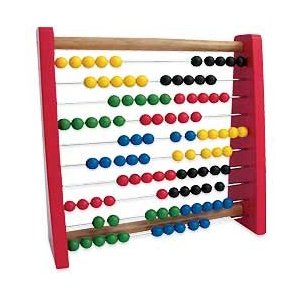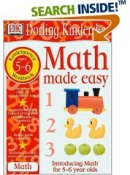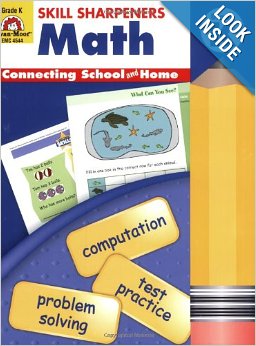
This is a comprehensive article about all aspects of kindergarten math, with recommendations for workbooks, and lists of free worksheet resources.
Disclosure: I get commissions for purchases made through Amazon links on this page.

The goal of kindergarten mathematics is to prepare children for first grade math. Please see below a list of objectives and goals for kindergarten math:
Children may also get started with money, time, and measuring, though it is not absolutely necessary to master any of that. The teacher should keep it playful, supply measuring cups, scales, clocks, and coins to have around, and answer questions.
During 1st grade, children will then learn addition and subtraction facts, two-digit numbers, some adding and subtracting with two-digit numbers, and some basics of measuring, time and money.
Mathematics starts with COUNTING. Let children count all kinds of things they see or use. Use simple counting games, such as:

One extremely helpful manipulative to buy is a basic 100-bead abacus (10 racks, 10 beads in each). This is the prime "toy" to teach numbers beyond ten. With such an abacus children will naturally learn their "tens and ones". I've written about the usage of abacus for learning place value here.
The best kind of abacus has each five beads in alternating colors, like the abacus from Schylling you see on the right.
If you can't get one with 5 and 5 beads in different colors, then get a regular abacus with 10 beads in each row, such as Melissa & Doug classic wooden abacus. You can browse Amazon's abacus selection here.
It is helpful to have concrete numbers (plastic or foam) that the children can touch. Other than that, games are again an excellent way to reinforce learning.
To recognize shapes and practice matching, you can either use ready-made worksheets or workbooks, or make some of your own.
If you make your own, you can just draw three circles on a page and then 2-5 triangles on a page, and ask the child to match each circle with a triangle by drawing a line from shape to shape. Vary the shapes and the amounts. Sometimes the amounts should be equal, sometimes not.
Another variation is to ask the child to draw. First make some sticks, circles, squares, or other shapes on a page, and encircle them. Make for the child a big "bubble" to draw in, and ask the child to draw either the same amount, one more, or one less.
Also have your child practice writing numbers on paper.

I like to recommend Math Made Easy: Kindergarten Workbook by Dorling Kindersley as it's of good quality and simple to use. The whole series of Math Made Easy workbooks is quite good.

Evan-Moore always publishes quality materials and their kindergarten workbook is no exception.
Yet another kindergarten math workbook to consider is Singapore Math — their EarlyBird Kindergarten Mathematics is praised a lot.
You can find lots more kindergarten math workbooks at Amazon. You don't need anything too fancy to practice these concepts, so workbooks from many different publishers can work equally well.
Additionally, these major educational publishers have a lot of kindergarten workbooks :
Many websites offer free materials for kindergarten math:
PrimaryLearning offers a large collection of kindergarten worksheets also; however you need a paid subscription to access them.
A child is ready for Math Mammoth complete first grade curriculum (Light Blue series) once he/she:
If you don't want to get a complete curriculum but prefer shorter books, then check out Addition 1 in Math Mammoth Blue Series as it is the first and easiest book of that series, suiting the beginning of 1st grade.
Both the 1st grade complete curriculum and the Addition 1 book start out dealing with addition within the range 0-10, but they also include missing addend problems such as 3 + __ = 7 and word problems. Kindergartners or younger children MAY get confused with the missing addend concept. If that happens, don't worry – just wait and let the child's brain mature.
By Maria Miller

Receive my monthly collection of math tips & resources directly in your inbox — and get a FREE Math Mammoth book!
We respect your email privacy.Confused about the different options? Take a virtual email tour around Math Mammoth! You'll receive: An initial email to download your GIFT of over 400 free worksheets and sample pages from my books. Six other "TOURSTOP" emails that explain the important things and commonly asked questions concerning Math Mammoth curriculum. (Find out the differences between all these different-colored series!)
This way, you'll have time to digest the information over one or two weeks, plus an opportunity to ask me personally about the curriculum. A monthly collection of math teaching tips & Math Mammoth updates (unsubscribe any time)
We respect your email privacy.
This is a little "virtual" 2-week course, where you will receive emails on important topics on teaching math, including: - How to help a student who is behind
- Troubles with word problems
- Teaching multiplication tables
- Why fractions are so difficult
- The value of mistakes
- Should you use timed tests
- And more! You will also receive: A GIFT of over 400 free worksheets and sample pages from my books right in the very beginning. A monthly collection of math teaching tips & Math Mammoth updates (unsubscribe any time)
Enter your email to receive math teaching tips, resources, Math Mammoth news & sales, humor, and more! I tend to send out these tips about once monthly, near the beginning of the month, but occasionally you may hear from me twice per month (and sometimes less often). Peek at the previous tips here. You will also receive: